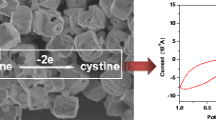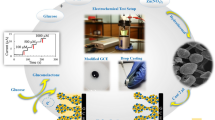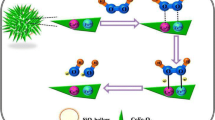Abstract
The authors report that CuOx/NiOy hollow nanocomposites are an effective bifunctional catalyst capable of oxidizing glucose and reducing hydrogen peroxide. Synthesis is based on a solvothermal process and subsequent thermal treatment. The structure can be controlled by adjusting the amounts of added NiCl2 during the solvothermal etching process, and core-shell, yolk-shell or hollow structures can be obtained. The porous hollow structure composite of type CuO30/NiO90 was used to modify a glassy carbon electrode. It exhibits excellent electrocatalytic activity towards glucose oxidation in solution of pH 13, typically at a working potential of +0.60 V (vs. Ag/AgCl). This enables voltammetric sensing of glucose with (a) a low limit of detection (0.08 μM, at S/N = 3), (b) over a wide linear range (0.20 μM - 2.5 mM), and (c) high sensitivity (2043 μA·mM−1·cm−2). The sensor is reproducible, selective and stable. It can be used to detect glucose in spiked human serum. The CuO30/NiO90 composite also displays good electrocatalytic activity towards reduction of H2O2 in neutral aqueous medium, typically at an applied potential of −0.35 V. It has a detection limit of 90 nM, a sensitivity of 271.1 μA·mM−1·cm−2, and a linear detection range that extends from 0.30 μM to 9.0 mM.

CuOx/NiOy nanocomposites with three different structures were synthesized by coordinated etching precipitation method. The hollow structure CuO30/NiO90 was coated on the surface of glassy carbon electrode for the amperometric determination of glucose and hydrogen peroxide.







Similar content being viewed by others
References
Xi J, Xie C, Zhang Y, Wang L, Xiao J, Duan X, Ren J, Xiao F, Wang S (2016) Pd nanoparticles decorated N-doped graphene quantum dots@N-doped carbon hollow nanospheres with high electrochemical sensing performance in cancer detection. ACS Appl Mater Interfaces 8:22563–22573
Lyu YP, Wu YS, Wang TP, Lee CL, Chung MY, Lo CT (2018) Hydrothermal and plasma nitrided electrospun carbon nanofibers for amperometric sensing of hydrogen peroxide. Microchim Acta 185:371
Zheng M, Li L, Gu P, Lin Z, Xue H, Pang H (2017) A glassy carbon electrode modified with ordered nanoporous Co3O4 for non-enzymatic sensing of glucose. Microchim Acta 184:943–949
Cheng C, Zhang C, Gao X, Zhuang Z, Du C, Chen W (2018) 3D network and 2D paper of reduced graphene oxide/Cu2O composite for electrochemical sensing of hydrogen peroxide. Anal Chem 90:1983–1991
Shu Y, Yan Y, Chen J, Xu Q, Pang H, Hu X (2017) Ni and NiO nanoparticles decorated metal-organic framework nanosheets: facile synthesis and high-performance nonenzymatic glucose detection in human serum. ACS Appl Mater Interfaces 9:22342–22349
Li SJ, Hou LL, Yuan BQ, Chang MZ, Ma Y, Du JM (2016) Enzyme-free glucose sensor using a glassy carbon electrode modified with reduced graphene oxide decorated with mixed copper and cobalt oxides. Microchim Acta 183:1813–1821
Zhang Y, Wang L, Yu J, Yang H, Pan G, Miao L, Song Y (2017) Three-dimensional macroporous carbon supported hierarchical ZnO-NiO nanosheets for electrochemical glucose sensing. J Alloys Compd 698:800–806
Zhao C, Wu X, Li P, Zhao C, Qian X (2017) Hydrothermal deposition of CuO/rGO/Cu2O nanocomposite on copper foil for sensitive nonenzymatic voltammetric determination of glucose and hydrogen peroxide. Microchim Acta 184:2341–2348
Dhara K, Mahapatra DR (2018) Electrochemical nonenzymatic sensing of glucose using advanced nanomaterials. Microchim Acta 185:49
Ma G, Yang M, Li C, Li C, Tan H, Deng L, Xie S, Xu F, Li W, Song Y (2016) Preparation of spinel nickel-cobalt oxide nanowrinkles/reduced graphene oxide hybrid for nonenzymatic glucose detection at physiological level. Electrochim Acta 220:545–553
Tan C, Chen J, Wu XJ, Zhang H (2018) Epitaxial growth of hybrid nanostructures. Nat Rev Mater 3:17089
Sun S, Yang Z (2014) Cu2O-templated strategy for synthesis of definable hollow architectures. Chem Commun 50:7403–7415
Sohn JH, Cha HG, Kim CW, Kim DK, Kang YS (2013) Fabrication of hollow metal oxide nanocrystals by etching cuprous oxide with metal (II) ions: approach to the essential driving force. Nanoscale 5:11227–11233
Wang Z, Luan D, Boey FYC, Lou XW (2011) Fast formation of SnO2 nanoboxes with enhanced lithium storage capability. J Am Chem Soc 133:4738–4741
Nai J, Tian Y, Guan X, Gou L (2013) Pearson’s principle inspired generalized strategy for the fabrication of metal hydroxide and oxide nanocages. J Am Chem Soc 135:16082–16091
Yu L, Wu HB, Lou XWD (2017) Self-templated formation of hollow structures for electrochemical energy applications. Acc Chem Res 50:293–301
Shang Y, Guo L (2015) Facet-controlled synthetic strategy of Cu2O-based crystals for catalysis and sensing. Adv Sci 2:1500140
Ma Z, Rui K, Zhang Q, Zhang Y, Du M, Li D, Wang Q, Huang X, Zhu J, Huang W (2017) Self-templated formation of uniform F-CuO hollow octahedra for lithium ion batteries. Small 13:1603500
Xia X, Wang Y, Ruditskiy A, Xia Y (2013) 25th anniversary article: galvanic replacement: a simple and versatile route to hollow nanostructures with tunable and well-controlled properties. Adv Mater 25:6313–6333
Yang S, Wang C, Chen L, Chen S (2010) Facile dicyandiamide-mediated fabrication of well-defined CuO hollow microspheres and their catalytic application. Mater Chem Phys 120:296–301
Fan HJ, Gösele U, Zacharias M (2007) Formation of nanotubes and hollow nanoparticles based on Kirkendall and diffusion processes: a review. Small 3:1660–1671
Yec CC, Zeng HC (2014) Synthesis of complex nanomaterials via ostwald ripening. J Mater Chem A 2:4843–4851
Zhang L, Cui Z, Wu Q, Gou D, Xu Y, Gou L (2013) Cu2O-CuO composite microframes with well-designed micro/nano structures fabricated via controllable etching of Cu2O microcubes for CO gas sensors. Cryst Eng Comm 15:7462–7467
Park JE, Hickey DR, Jun S, Kang S, Hu X, Chen XJ, Park SJ (2016) Surfactant-assisted emulsion self-assembly of nanoparticles into hollow vesicle-like structures and 2D plates. Adv Funct Mater 26:7791–7798
He G, Tian L, Cai Y, Wu S, Su Y, Yan H, Pu W, Zhang J, Li L (2018) Sensitive nonenzymatic electrochemical glucose detection based on hollow porous NiO. Nanoscale Res Lett 13:3
Cao CY, Guo W, Cui ZM, Song WG, Cai W (2011) Microwave-assisted gas/liquid interfacial synthesis of flowerlike NiO hollow nanosphere precursors and their application as supercapacitor electrodes. J Mater Chem 21:3204–3209
Lin LY, Karakocak BB, Kavadiya S, Soundappan T, Biswas P (2018) A highly sensitive nonenzymatic glucose sensor based on cu/Cu2O/CuO ternary composite hollow spheres prepared in a furnace aerosol reactor. Sensors Actuators B Chem 259:745–752
Chen D, Wang H, Yang M (2017) A novel ball-in-ball hollow NiCo2S4 sphere based sensitive and selective nonenzymatic glucose sensor. Anal Methods 9:4718–4725
Zhang Y, Wang Y, Jia J, Wang G (2012) Nonenzymatic glucose sensor based on graphene oxide and electrospun NiO nanofibers. Sensors Actuators B Chem 171:580–587
Bai X, Chen W, Song Y, Zhang J, Ge R, Wei W, Jiao Z, Sun Y (2017) Nickel-copper oxide nanowires for highly sensitive sensing of glucose. Appl Surf Sci 420:927–934
Guo W, Sun W, Wang Y (2015) Multilayer CuO@NiO hollow spheres: microwave-assisted metal-organic-framework derivation and highly reversible structure-matched stepwise lithium storage. ACS Nano 9:11462–11471
Liu X, Yang W, Chen L, Jia J (2017) Three-dimensional copper foam supported CuO nanowire arrays: an efficient nonenzymatic glucose sensor. Electrochim Acta 235:519–526
Liu X, Yang W, Chen L, Jia J (2016) Synthesis of copper nanorods for non-enzymatic amperometric sensing of glucose. Microchim Acta 183:2369–2375
Zhang K, Zhang N, Cai H, Wang C (2012) A novel non-enzyme hydrogen peroxide sensor based on an electrode modified with carbon nanotube-wired CuO nanoflowers. Microchim Acta 176:137–142
Acknowledgements
We gratefully acknowledge financial support from the National Natural Science Foundation of China (No. 21675147) and the Ministry of Science and Technology of China (No. 2016YFC1400601).
Author information
Authors and Affiliations
Corresponding author
Ethics declarations
The author(s) declare that they have no competing interests.
Additional information
Publisher’s Note
Springer Nature remains neutral with regard to jurisdictional claims in published maps and institutional affiliations.
Electronic supplementary material
ESM 1
(DOCX 5345 kb)
Rights and permissions
About this article
Cite this article
Long, L., Liu, X., Chen, L. et al. A hollow CuOx/NiOy nanocomposite for amperometric and non-enzymatic sensing of glucose and hydrogen peroxide. Microchim Acta 186, 74 (2019). https://doi.org/10.1007/s00604-018-3183-x
Received:
Accepted:
Published:
DOI: https://doi.org/10.1007/s00604-018-3183-x




